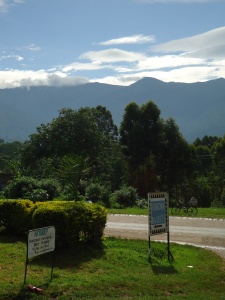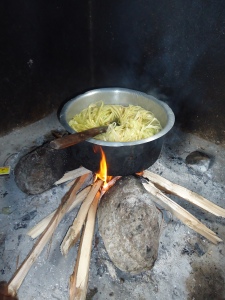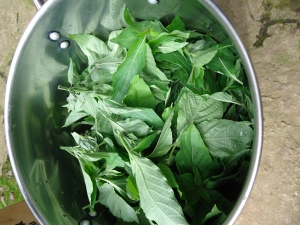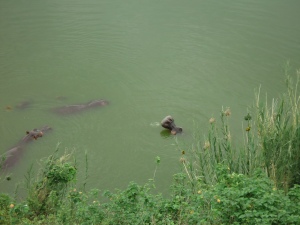A few days ago I booked my tickets to Indonesia! I’m arriving in Bali on April 21, and my impending departure has kicked my planning into overdrive for my last few days in Uganda (the Pearl of Africa indeed). I made a to-do list of things I’m hoping to accomplish before I go and am determined to check them all off. Successes so far:
1. Visit the natural dye center at Rubona Basket Weavers Association
Rubona is a little town in western Uganda, on the road between Fort Portal and Kasese. I arrived there on a drizzly Friday morning after spending a night in Fort Portal in the blue shadows of the Rwenzori Mountains.
The women at the Rubona Basket Weavers Association are well-known for their distinctive, beautiful naturally dyed baskets, made with raffia, millet straw, and banana fiber. I’d seen their baskets for sale in Kampala and I finally managed to arrange a visit to learn more about their weaving techniques and the natural dyes.
The amazing variety of brightly dyed raffia, all colored with natural materials.
The project began in 2005, when an Austrian man trained local women in natural dye techniques—reviving some dye practices that women had been using for years. It’s grown to employ over 200 local women. The managers, Kellen and Nnalongo, walked me through the dye process step by step. First we boiled the raffia to soften it:
Then we prepared the ingredients:
Omfoka leaves (fresh; used for making green or black)
Akalamata root (fresh or dried; used for making red)
Amarwa gempunu roots (fresh; used for making maroon and yellow)
Pounding the amarwa gempunu in a big mortar:
Chop chop
Cosmos flower (fresh or dried; used for making orange and red)
Kellen mixing in wood ash:
Raffia drying:
As a business, Rubona is doing really well; their main market is the chain of Banana Boat stores, an upscale Kampala craft outlet (I was lucky enough to have an interesting conversation with BB’s co-owner, and hopefully I’ll give you a report on that and other craft-related interviews soon). One aspect of Rubona’s business model that especially impressed me is their approach to design innovation. Many craft producers get ideas for new product designs from their marketers (Ten Thousand Villages, for example, sends new designs to many of its producers each season). The Rubona basket designs, however, come directly from the women.
Each month Rubona holds a design contest for all the basketweavers—this month’s challenge is millet baskets, a distinctive basket shape with a tight-fitting conical lid that has a little handle at the top. (On the day that I visited, the eleven zone leaders were attending a workshop at the center to learn how to refine their technique for weaving the millet basket shape. They’re responsible for passing on that skill to the weavers in their zone.) Creators of the top designs win prizes, which are generally practical home and kitchen items. In this way, Rubona encourages design innovation and creativity and actively avoids the problem of product stagnation.
And the results are stunning:
CHECK.
2. See Animals!
After leaving Rubona, I hopped on a matatu south, heading for Queen Elizabeth National Park. It was dusk by the time my matatu crossed the park boundary. Almost as soon as we were inside the park, the wildlife sightings began! First, a herd of more than a hundred graceful golden-brown Uganda kob, with their beautiful spirally horns. Later, the car slowed wayyy down for a family of five elephants (including a little one!!). From the village of Katunguru, just outside the park gates, I paid for a special hire taxi to drive me to a hostel inside the park. On the way, we saw three enormous lumbering hippos who had ventured out of the water to do their nocturnal grazing.
At the hostel I met three young Dutch women, nursing students doing an internship in a hospital here, and we agreed to share the cost of a game drive the next morning. We left at 6:30 am, and the sky was too dark for me to get any pictures of our first game sighting—more elephants!!! We headed into the savannah area where the Uganda kob have their mating grounds.
As promised… animals!!
Vultures!
Hyena!
Uganda kob!
LIONS!
Not pictured: buffalo, waterbuck, elephants. All spectacular!
Unfortunately my pictures really didn’t turn out very well—something about the cloudy just-after-dawn light didn’t agree with my camera. These images don’t capture the beauty of the golden savannah, the distinctively shaped trees, and the towering, misty blue mountains across the border in the DRC that formed the backdrop to every view.
After the game drive, I got lucky and hitched a free ride back to Katunguru in a park pickup truck packed with about twenty other passengers. In Katunguru, I spent a little while walking along the Kazinga Channel, which connects Lake Edward and Lake George. I watched a family of hippos hanging out near the shore, and got serenaded by the many bright-yellow weavers that make their hanging nests in the reeds along the banks.
I got a little picture-happy with the hippo family (you would too!!)
Look at the baby hippo in this one!!!
CHECK. To be continued!























Hi,
that was a great article about the Rubona Basket Weavers, thank you so much for portraying the project in such a professional manner. It is really a unique project and the women deserve all publicity they can get.
By the way, I am that ‘man from Austria’ who……….
Nice journey and good luck! Rupert
Vry excited to read your comments. I am a basket worker in Cape Town, South Africa. I would love to import some baskets from Ugan
da. Are you able to give me some contact details – would be most grateful binky@mweb.co.za